According to a 2003 article in Dynamic Chiropractic, "Despite a century of debate by chiropractic leaders, a new university-based survey of North America's practicing doctors of chiropractic reveals a surprising degree of unity on most issues.
Based on surveys such as these, I am quite certain that the working technique repertoire of most chiropractors is fairly similar, including both adjustive and diagnostic procedures. Having personally met most of the chiropractic college technique department chairs, as well as having served on NBCE technique committees for many years, I have a pretty good sense of what is being taught at chiropractic colleges in North America. Although the terminology and emphases vary, all contemporary chiropractic students acquire a basic repertoire of adjustive and patient assessment procedures, including but not limited to palpation.
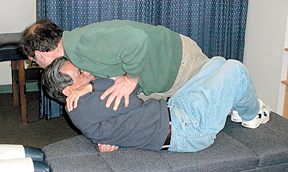 Fig 1: Supine setup in pre-stress.
On top of this basic repertoire that all chiropractic students learn, individual chiropractors distinguish themselves by acquiring skills or developing protocols that lie somewhat outside this basic repertoire. This may take the form of a diplomate program and degree, certification in a proprietary technique system, utilization of specialized treatment or diagnostic equipment, development of specialized management protocols for one or more identified patient conditions, or customized development and enhancement of otherwise mainstream technique procedures.
Fig 1: Supine setup in pre-stress.
On top of this basic repertoire that all chiropractic students learn, individual chiropractors distinguish themselves by acquiring skills or developing protocols that lie somewhat outside this basic repertoire. This may take the form of a diplomate program and degree, certification in a proprietary technique system, utilization of specialized treatment or diagnostic equipment, development of specialized management protocols for one or more identified patient conditions, or customized development and enhancement of otherwise mainstream technique procedures.
In part, we are motivated to acquire distinguishing skills and attributes in order to perform well in the chiropractic marketplace, which includes many "competing brands" of chiropractors and chiropractic services. More importantly, I would like to think we acquire these distinguishing skills and attributes in order to promote improved patient outcomes and outperform what we find in that basic repertoire the colleges offer.
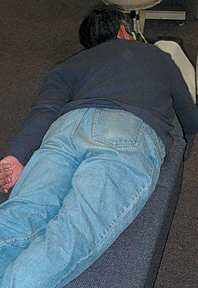 Fig. 2: Pre-positioning for pre-stressed posterior adjustment.
Like every other chiropractor, I have developed a certain collection of technique enhancements that I regard as somewhat unusual or atypical. I would like to take this opportunity to list and briefly describe my 10 most important enhancements; that is, divulge my trade secrets!
Fig. 2: Pre-positioning for pre-stressed posterior adjustment.
Like every other chiropractor, I have developed a certain collection of technique enhancements that I regard as somewhat unusual or atypical. I would like to take this opportunity to list and briefly describe my 10 most important enhancements; that is, divulge my trade secrets!
1. Pre-stressed thoracic and lumbar adjusting.4 In designing a manipulative approach to the thoracolumbar transitional area, the doctor should take into account possible lateral curvature of the spine, as well as global movement restrictions. For example, a patient with either left lateral curvature or restriction in left lateral bending should be pre-stressed into a left lateral bent position prior to a thrust being applied. This is in accordance with the stress reversal analysis previously described by Winterstein and subsequently refined by others, such as Pettibon, Harrison, Troyanovich and myself.5 This would apply to either a supine setup, performing an anterior thoracic or lumbar adjustment, or to a prone setup, using any of the common approaches (double hypothenar, double transverse, double thenar, single-hand contact). Figure 1 shows a supine setup in left pre-stress, while Figure 2 shows pre-positioning for a pre-stressed posterior adjustment. This beats the heck out of using "torque to close the wedge." If you want to close wedges, just close them with the setup prior to thrusting.
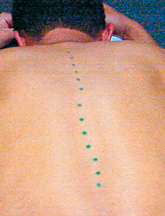 Fig. 3: Presentation of tortithoracis; a more or less linear offset of a row of spinous processes.
2. Detection and correction of tortithoracis.6,7 Physical examination reveals a more or less linear offset of a row of spinous processes, as in Figure 3. It can be determined by palpation of the transverse processes that the segmental discontinuity is essentially rotatory in nature. Palpation of the transverse processes, with posteriority opposite the side of spinous process deviation, confirms rotational misalignment, as opposed to lateralisthesis. No doubt in some offices, the patient would be found to have a "rib head" out or perhaps intercostal neuralgia, and correctly so. However, tortithoracis appears to be a more inclusive dysfunctional complex involving the costovertebral, costotransverse and intervertebral facetal joints.
Fig. 3: Presentation of tortithoracis; a more or less linear offset of a row of spinous processes.
2. Detection and correction of tortithoracis.6,7 Physical examination reveals a more or less linear offset of a row of spinous processes, as in Figure 3. It can be determined by palpation of the transverse processes that the segmental discontinuity is essentially rotatory in nature. Palpation of the transverse processes, with posteriority opposite the side of spinous process deviation, confirms rotational misalignment, as opposed to lateralisthesis. No doubt in some offices, the patient would be found to have a "rib head" out or perhaps intercostal neuralgia, and correctly so. However, tortithoracis appears to be a more inclusive dysfunctional complex involving the costovertebral, costotransverse and intervertebral facetal joints.
Acute tortithoracis is best addressed using an anterior thoracic adjustive procedure, whereas chronic tortithoracis responds better to a prone thrust. In the prone protocol, each of the doctor's two hands contacts a different vertebra, one on either side of the spine, according to the rotational parameters of the subluxated joint (Figure 4). This is not unlike the procedure discussed in Applied Kinesiology to adjust a "fixation" (as compared to "subluxation").8
3. Anterior cervical syndrome.9 Diagnostic protocol involves the following:
- Palpate thenar pads, digits one to five touching.
- Inspect thenar pads for atrophy.
- Check opponens pollicis muscle strength, digits one to two touching.
- Check wrist flexor strength.
- Check peroneus tertius strength.
- If any muscle weakness, re-check with cervical distraction, then compression.
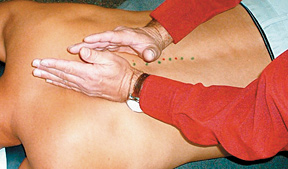 Fig. 4: Prone thrust for correcting torithoracis.
Herman Kabat, co-developer of the proprioceptive neurofacilitation technique, wrote a book describing an examination procedure for identifying occult cervical disc pathology.10 Resembling procedures used in AK and SOT, it assesses the strength of certain muscles as the neck is compressed and distracted. There are two ways of establishing the need for the supine anterior cervical break adjustment: The patient either satisfies Kabat's criteria or they exhibit spinous process rotation toward the side of lower cervical fixation.
Fig. 4: Prone thrust for correcting torithoracis.
Herman Kabat, co-developer of the proprioceptive neurofacilitation technique, wrote a book describing an examination procedure for identifying occult cervical disc pathology.10 Resembling procedures used in AK and SOT, it assesses the strength of certain muscles as the neck is compressed and distracted. There are two ways of establishing the need for the supine anterior cervical break adjustment: The patient either satisfies Kabat's criteria or they exhibit spinous process rotation toward the side of lower cervical fixation.
In the anterior cervical break, the segmental contact point is on the anterior aspect of the transverse process of a lower vertebra on the involved side of the neck, and the thrust is mostly lateral to medial, but somewhat anterior to posterior. If you are going to be doing this adjustment, please be aware that it is one of those handful of adjustments that hurt when they do not go.
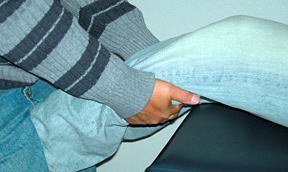 Fig. 5: Positioning for long-axis hip distractive manipulation.
4. Long-axis hip distractive manipulation.11 The patient is placed supine on a pelvic bench. Flexing the knee slightly, the doctor grasps and distracts the entire lower extremity. They may supplant the tugging force of the arms by placing the patient's leg between the doctor's legs, while leaning backward, as in Figure 5. With the lower extremity distracted, the doctor circumducts the entire lower extremity alternatively clockwise and counterclockwise, taking heed of the patient's tolerance while gradually increasing the circumference of the "orbit." After some minutes of this, the doctor, after warning the patient, suddenly pulls on the leg so as to pull the head of the femur away from the acetabulum. Generally, but not always, this HVLA pull is accompanied by an audible sound that appears to come from the hip.
Fig. 5: Positioning for long-axis hip distractive manipulation.
4. Long-axis hip distractive manipulation.11 The patient is placed supine on a pelvic bench. Flexing the knee slightly, the doctor grasps and distracts the entire lower extremity. They may supplant the tugging force of the arms by placing the patient's leg between the doctor's legs, while leaning backward, as in Figure 5. With the lower extremity distracted, the doctor circumducts the entire lower extremity alternatively clockwise and counterclockwise, taking heed of the patient's tolerance while gradually increasing the circumference of the "orbit." After some minutes of this, the doctor, after warning the patient, suddenly pulls on the leg so as to pull the head of the femur away from the acetabulum. Generally, but not always, this HVLA pull is accompanied by an audible sound that appears to come from the hip.
5. Subclinical torticollis.12 In a patient with a typical complaint of "stiff neck," the doctor finds ipsilateral lateral flexion restriction and rotation restriction. The patient simply does not want to bend or rotate toward the same side. These are the same motion findings that would be found in torticollis, although the head is not in the classic cock-robin position; there is no "wry neck." Therefore, it would be fair to call this pattern "subclinical torticollis." Based on comments by Grieve and consistent with my own observations, the problem generally turns out to be a significant rotational subluxation in the upper cervical spine, and is treated accordingly.13 It can be statically palpated and adjusted as such. I have also consistently noted that there will be a tight and exquisitely tender supraclavicular muscle fiber (either SCM or the anterior scalene) opposite the side of restriction.
References
- "New Study Finds Unity in Chiropractic." Dynamic Chiropractic, June 2, 2003. www.chiroweb.com/mpacms/dc/article.php?id=9234.
- MacDonald W. How Chiropractors Think and Practice: The Survey of North American Chiropractors. Institute for Social Research at Ohio Northern University, 2003.
- Christensen MG. Job Analysis of Chiropractic. A Project Report, Survey Analysis and Summary of the Practice of Chiropractic Within the United States. Greeley, CO: National Board of Chiropractic Examiners, 2005.
- Cooperstein R. The pre-stressed anterior thoracolumbar adjustment. J Am Chiropr Assoc, 2004;41(6):38-40.
- Winterstein J. Spinal distortion and stress reversal. J Am Chiropr Assoc 2001;38(11):44-5.
- Cooperstein R. "Tortithoracis: A Name in Search of a Condition." Dynamic Chiropractic, 1998;16(11):32-3.
- Cooperstein R. Tortithoracis. J Am Chiropr Assoc, 2004;41(4).
- Walther DS. Applied Kinesiology, Volume I. Pueblo, Colo.: Systems DC, 1981.
- Cooperstein R. "The Anterior Cervical Break." Dynamic Chiropractic, Jan. 15, 2005. www.chiroweb.com/archives/23/02/07.html.
- Kabat H. Low Back and Leg Pain From Herniated Cervical Disc. St. Louis: Warren H. Green, Inc., 1980.
- Cooperstein R. Chiropractic philosophy and technique: mobilizing and manipulating the arthritic hip. J Am Chiropr Assoc, July 2009.
- Cooperstein R. ROM Analysis of the cervicothoracic region: interpretation of gross patterns. J Am Chiropr Assoc, 2008;45(3):13-5.
- Grieve G. Common Vertebral Joint Problems. 2nd Edition. New York: Churchill Livingstone, 1988.
Part 2 of this article, scheduled to appear in the Dec. 16 issue, will discuss trade secrets 6-10.
Click here for previous articles by Robert Cooperstein, MA, DC.





